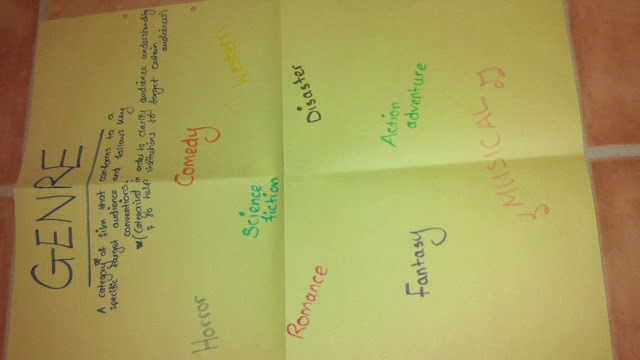L Taylor AS Media Production 2014
Friday 16 May 2014
Our Final Opening Title Sequence: 'Voluptuous Vehemence'
Voluptuous Vehemence from SCHS TV on Vimeo.
We were finally able to sort out the technical difficulties with uploading our OTS to Vimeo, with help from the school technician! So this is the final edit of Voluptuous Vehemence, enjoy!
Sunday 13 April 2014
Evaluation
Below is the link to the website I created to evaluate my opening title sequence. I found that I learned and improved various skills from the wide use of different formats for my answers!
http://lanekatie97.wix.com/voluptuousvehemence
http://lanekatie97.wix.com/voluptuousvehemence
Tuesday 4 March 2014
Technical Issues with Audio
After having uploaded Billie's music to the OTS (which took a lot of experimentation and Google searches to work out how to spread it across the whole of the OTS), I realised there was a problem with the audio. When I played it all back and watched it, I noticed a small section of the OTS where neither the voiceover or the background music could be heard, and then the sound came back and simply carried on. I don't know why this is happening but I will seek support with finding out why and how to resolve the issue.
Update: I Googled this and it seems that this is quite a common issue as others seem to be experiencing similar problems to me. I cannot find any answers to this, however, and so I will talk to my teacher when I see her next.
Second update: I've just figured out what the problem was! I went onto the audio adjustments for the clips that the sound cut off with and 'ducking' was ticked! This meant that other audio tracks attached were reduced in volume.
Our opening title sequence is now finished! :)
Sunday 2 March 2014
Music
I had given my good friend, Billie Bell, the task of composing music for our OTS, and had given him a list of the sort of atmosphere we were looking for. He had also sat down with me to view our OTS draft so that he could get a feel for the story and the time etc. (I suggested he filmed it via his phone so that he could refer back to it, so this is what he did).
This is the beautiful piece of music that he has composed for us, and I think it conforms to our narrative and Neo-Noir genre perfectly. Thank you so much, Billie!
This is the beautiful piece of music that he has composed for us, and I think it conforms to our narrative and Neo-Noir genre perfectly. Thank you so much, Billie!
Thursday 27 February 2014
Production Roles
My role throughout this project has included filming, most of the editing and organising actors, locations and music. Meanwhile, Eloise has focused on directing, cinematography, overall organisation (eg. props and setting us jobs) and some of the editing.
Animatic Complications
I created an animatic of our opening title sequence over a month ago but Eloise and I unfortunatley couldn't locate where it was saved and we forgot about it, deciding that we didn't have time to complete another one before the deadline.
However, yesterday, we found the animatic on a different computer! So I exported, compressed and uploaded it to Vimeo in an attempt to post it to my blog. But Vimeo didn't allow me to upload it for reasons unknown, and I have been told that this has been a reoccuring problem for the media department recently.
However, yesterday, we found the animatic on a different computer! So I exported, compressed and uploaded it to Vimeo in an attempt to post it to my blog. But Vimeo didn't allow me to upload it for reasons unknown, and I have been told that this has been a reoccuring problem for the media department recently.
And so, I will do my best to find a way to resolve the issue, as I spent a fair amount of time on my animatic.
Monday 20 January 2014
Femme Fatale Scene
Once having uploaded our footage, we noticed that what we had didn't quite work. This is because:
To resolve this issue, Eloise has now re-shot this scene at her house so that she was able to experiment with lighting and mise-en-scene etc. It is much better quality.
- The lighting was inconsistent because it was darker than the rest of the footage, as we filmed this later in the evening.
- Furthermore, the smoke from the electric cigarette didn't show up on the camera when we watched it back, and this is an important factor as it is part of an action match.
To resolve this issue, Eloise has now re-shot this scene at her house so that she was able to experiment with lighting and mise-en-scene etc. It is much better quality.
Thursday 16 January 2014
First Day(s) of Filming
Due to Eloise's work & my Grease rehearsals, it has been very difficult for us to find time for filming. Although we found time to do so last Wednesday, we didn't manage to get much done. We found some locations in the city (& took some photographs that I will post soon) & shot a small amount of footage before the batteries ran out on the camera which-as we discovered when we got to Norwich- had not been charged. We even had difficulties with transport getting into the city, as we waited at the bus stop for approximately 50 minutes waiting for a bus that never showed up & then got on the later bus only to have a disruption on the way which wasted more of our time! Our actors were not very happy as they had been waiting for us in the city for all this time but there was nothing we could do about it, & then for our cameras to die after going through all this trouble of transport was guttering for Elly & I!
The only other day we were both available to film was this Wednesday (yesterday), and so- as we had two periods of Media Studies in the afternoon- we got our teachers' permissions to leave the school at lunch time in order to allow us more filming time in the city. Luckily, our actress who plays the part of the anti-hero (Leannan) had free periods in the afternoon, however, Lydia (who was originally going to play the part of the femme fatale) couldn't join us this quickly & was quite busy so wouldn't be able to spend much time filming. Eloise then put forward the idea that she would play the femme fatale (& these would be the scenes that I would need to take on her roles of director & cinematographer as well as my role of camerawoman) so that we could ensure that she is always available when we want to film. We returned to the locations & filmed from the beginning, ending up with approximately six & a half hours spent in the city before we returned home extremely tired but glad that we got most of the filming completed!
All that is left to film now is:
The only other day we were both available to film was this Wednesday (yesterday), and so- as we had two periods of Media Studies in the afternoon- we got our teachers' permissions to leave the school at lunch time in order to allow us more filming time in the city. Luckily, our actress who plays the part of the anti-hero (Leannan) had free periods in the afternoon, however, Lydia (who was originally going to play the part of the femme fatale) couldn't join us this quickly & was quite busy so wouldn't be able to spend much time filming. Eloise then put forward the idea that she would play the femme fatale (& these would be the scenes that I would need to take on her roles of director & cinematographer as well as my role of camerawoman) so that we could ensure that she is always available when we want to film. We returned to the locations & filmed from the beginning, ending up with approximately six & a half hours spent in the city before we returned home extremely tired but glad that we got most of the filming completed!
All that is left to film now is:
- different camera angles revealing the dead body (which I aim to do tonight, using Connor rather than our original actor, Toby, due to Connor's availability & short distance from my house)
- an extreme close-up of Connor slowly opening his eyes (which I also intend to do tonight)
- Eloise walking up to a front door (which we will film as soon as the time is available)
- a shot of Eloise framed through a letter box (which we will also film as soon as the time is available)
Time Management
Week beginning 13th January
- finish filming footage
- start editing to complete first cut
- create studio & production idents/screens
Week beginning 20th January
- finalize first cut so that it's ready for feedback
- preparation for presentation of first cut
- send Billie first cut for preliminary composition of music
Week beginning 27th January
- first focus group work with peers & teachers
- re-editing
- planning & completion of any re-shoots
- planning construction of sound
Week beginning 3rd February
- construction of sound
- finish all titles
- final edits of film OTS
Week beginning 10th February
- exhibition & distribution of first cut of final films shared on social networks for the purpose of focus group feedback
- use surveys/questionnaires (surveymonkey) & allow time for feedback
- work on blog to ensure all the above is evidenced (talking head, reflective note, production plans, slideshares etc)
Week beginning 17th February (half term)
- complete focus group research
- complete blog
- plan final improvements to productions in response to the feedback
Deadline for completed Research & Planning Blogs & First Drafts of Productions is the 28th February (Friday after half term)
Wednesday 18 December 2013
Deciding on the Title Font and Effect
We asked to use our peers as a focus group to decide which font they believed conformed the best to the Film Noir genre and also which was most attractive in their opinion. We did this by creating a video on iMovie where the same title would appear but with various different fonts and took a vote afterwards. The above font is the final choice.
The two effects displayed above were chosen by Elly and I to decide between. However, the typewriting style effect causes the letters to overlap in a way that makes the title unclear, and so that assisted us in deciding on the simple swiping effect.
Monday 16 December 2013
Things We Need To Consider
4 Areas to Cover
Health & Safety
Ethics
Film Classifications
Copyright
Health & Safety
- Consider actors' health and safety (location, props, dress code)
- Vision & movement issues during filming (restriction particularly during motion- etc. tracking, panning)
- Risk assessment
- Notions of protection
Ethics
- Right & wrongs VS responsibilities
Film Classifications
Copyright
- You cannot use someone else's work
Tuesday 10 December 2013
Continuity Task
Continuity task final edit from morrighan humpleby on Vimeo.
The continuity task was completed in order for us to practice both the Film Noir conventions (lighting, music, costume, props etc) and various camera techniques including the 180 degree rule and match on action etc. This also allowed us to recall/learn how to edit using iMovie. For myself, it was only recalling due to the editing I did during my GCSE Media Studies course.
After having watched it ourselves and then presenting our work to a focus group (consisting of our class peers), we became aware of some areas for improvement. These included:
- Mise-en-scene; Ailbhe (our actor whom played the 'girl next door' character) was wearing converse because we didn't prepare more conforming shoes for that character. This was the point most recognised by our focus group.
- Non-believable acting; A few of the sheets we handed to our focus group commented that the acting was too 'wooden'and therefore non-believeable. This is due to the rush of organization as we didn't have long to plan and complete this task, and so we didn't have time to find more professional actors.
- Fluidity; Another issue brought up a few times was that the beginning didn't flow enough and peers suggested that we could improve by making faster cuts at the beginning, which we then took into account and adjusted on iMovie.
Wednesday 4 December 2013
Narrative Planning of our Opening Title Sequence- Stage 1
After having planned our initial storyline, Eloise and I (a.k.a. 'BB Productions') had the idea to find a poem to use as the speech for the anti-hero's narrating voiceover. We found one that we really liked and thought conformed to our storyline, however it was copyrighted as it was found on the internet. There was a contact email address on the website in case of people wanting to ask permission, and so we conducted this email to send to the poet:
Within just a few hours of sending this, we were very thankful to recieve a reply from the poet!
This is the poem that we have recieved permission to use in our OTS, called Collusion of Silence by Matt Castaneda. We have decided to only use the first verse in our OTS, however, if we were to make the whole film, we would have used the rest of the poem for when the anti-hero commits suicide (which is our idea for what would happen if the film was full). The following poem is copyright to Matt Castaneda:
Source: Relief From Feeling Alone Poem, Collusion Of Silence http://www.familyfriendpoems.com/poem/collusion-of-silence#ixzz2mYN7cike
Family Friend Poems
Within just a few hours of sending this, we were very thankful to recieve a reply from the poet!
This is the poem that we have recieved permission to use in our OTS, called Collusion of Silence by Matt Castaneda. We have decided to only use the first verse in our OTS, however, if we were to make the whole film, we would have used the rest of the poem for when the anti-hero commits suicide (which is our idea for what would happen if the film was full). The following poem is copyright to Matt Castaneda:
Collusion Of Silence
© Matt C.
I live everyday with everlasting shame,
with everlasting regret,
with everlasting pain,
Why? What have I done to beget?
I don't forget, like a tight corset
of the pain that tightly constrains my soul
and turns my heart into deep, dark coal.
So there's nothing left to do,
except load this bullet and blow straight through.
For every somber moment,
every haphazard mistake,
every broken promise,
every failure,
all my doubt,
all my lost hope,
all my poisoned love,
can go straight through
the bullet hole I just blew.
Now, they can escape to the surface,
in hopes of a higher purpose, because I'm sadly through.
One bullet, one dream, one doubt,
and the one fire no one helped to put out.
So say goodbye,
and don't forget to say hi
to my demons passing by;
For I am Satan's now,
no matter how hard I cry.
No one can hear me anymore,
forever suffering, forever silent, forever I die.
with everlasting regret,
with everlasting pain,
Why? What have I done to beget?
I don't forget, like a tight corset
of the pain that tightly constrains my soul
and turns my heart into deep, dark coal.
So there's nothing left to do,
except load this bullet and blow straight through.
For every somber moment,
every haphazard mistake,
every broken promise,
every failure,
all my doubt,
all my lost hope,
all my poisoned love,
can go straight through
the bullet hole I just blew.
Now, they can escape to the surface,
in hopes of a higher purpose, because I'm sadly through.
One bullet, one dream, one doubt,
and the one fire no one helped to put out.
So say goodbye,
and don't forget to say hi
to my demons passing by;
For I am Satan's now,
no matter how hard I cry.
No one can hear me anymore,
forever suffering, forever silent, forever I die.
Source: Relief From Feeling Alone Poem, Collusion Of Silence http://www.familyfriendpoems.com/poem/collusion-of-silence#ixzz2mYN7cike
Family Friend Poems
Thursday 14 November 2013
The Difference Between an Animatic and a Storyboard
A storyboard is defined as 'a sequence of drawings, typically with some directions and dialogue, representing the shots planned for a film or television producton.' Here is an example of a storyboard:

The definition for an animatic is 'a preliminary version of a film, produced by shooting successive sections of a storyboard and adding a soundtrack.'
The difference between the two planning techniques is that, while a storyboard is a collection of images displaying what the various shots will entail, an animatic of the same project would use the same images (whether drawn or photographed etc.) and create a slideshow with them including added sound/music. This enables you to determine how long each shot will last and the transitions you plan to have between each shot/scene.

The definition for an animatic is 'a preliminary version of a film, produced by shooting successive sections of a storyboard and adding a soundtrack.'
The difference between the two planning techniques is that, while a storyboard is a collection of images displaying what the various shots will entail, an animatic of the same project would use the same images (whether drawn or photographed etc.) and create a slideshow with them including added sound/music. This enables you to determine how long each shot will last and the transitions you plan to have between each shot/scene.
Monday 11 November 2013
Creating the atmosphere of a Film Noir using photography
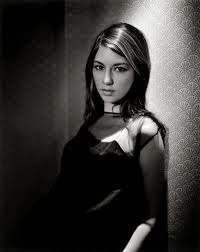
Once we had captured our Film Noir styled photographs, I found these images by other artists that I can compare them to:
With this image, we attempted to capture the seductive manner of the femme fatale. It gives the impression that she is awaiting something to happen, or someone to meet. There is light behind their heads, portraying them (falsely) as angelic.
With this image, we experimented with lighting so that we created a shadow behind the character, which gives the sense of a dark and haunting past shadowing them.
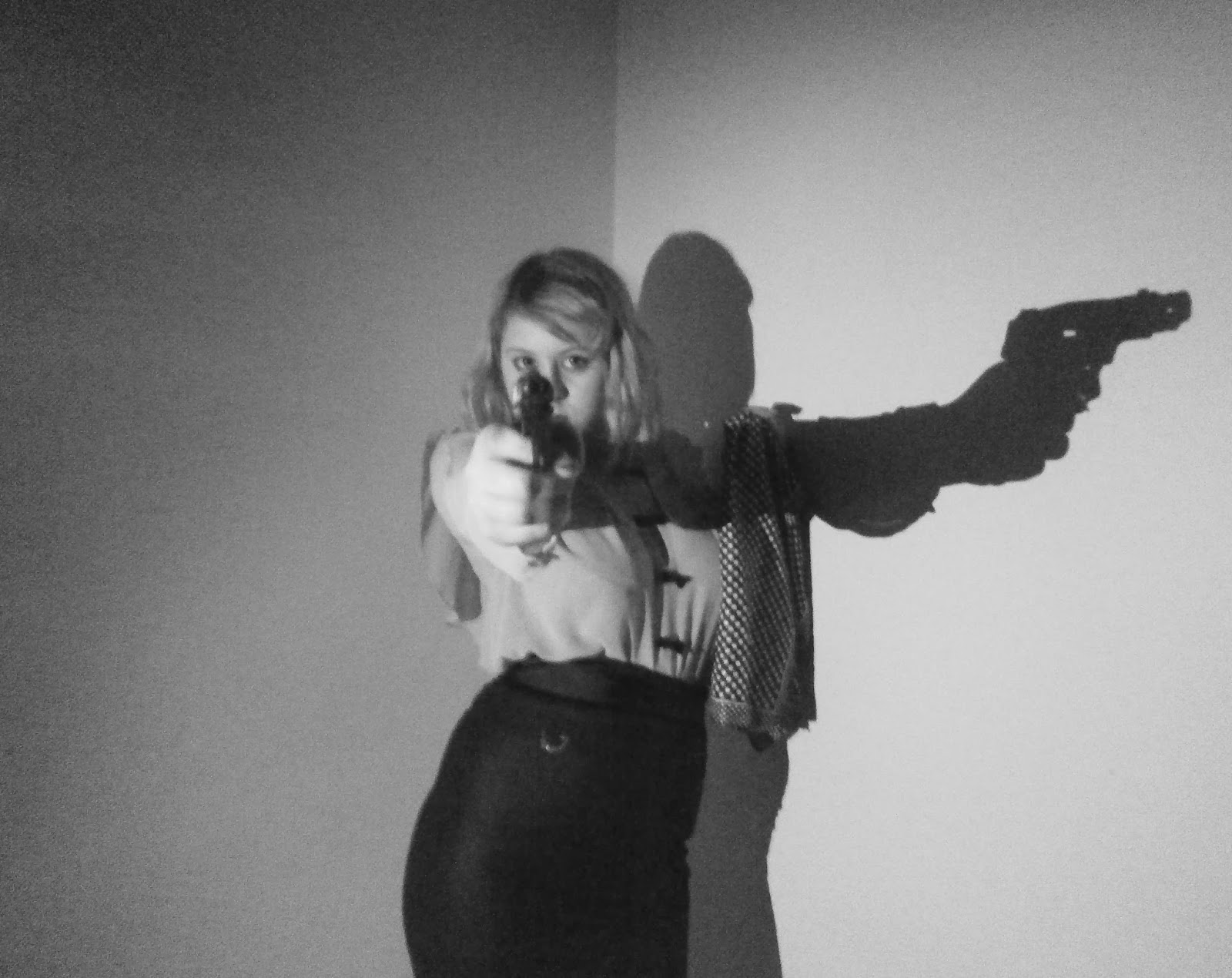 With this image, we wanted to create intensity by having the gun point directly at the camera. We also created a shadow on the wall for the same reason as previously mentioned.
With this image, we wanted to create intensity by having the gun point directly at the camera. We also created a shadow on the wall for the same reason as previously mentioned.  With this image, we created a sense of danger from an unknown source. We did this by positioning the shadow of a gun pointed at Courtney (the victim) against the wall. Mystery is an important factor in a film Noir.
With this image, we created a sense of danger from an unknown source. We did this by positioning the shadow of a gun pointed at Courtney (the victim) against the wall. Mystery is an important factor in a film Noir.  With this image, we created the femme fatale character; dressed in a long dress, smoking, with a large shadow against the wall behind her (to represent either a dark side to her character or a dark and troubled past).
With this image, we created the femme fatale character; dressed in a long dress, smoking, with a large shadow against the wall behind her (to represent either a dark side to her character or a dark and troubled past).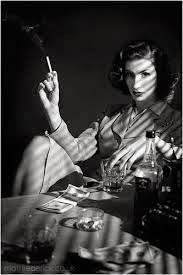 With this image, we intended to create interesting shadows across the character's face in order to signify danger and/or a dark side to the character. The photograph leads the viewers eye from the gun to its shadow and finally Eloise's eye.
With this image, we intended to create interesting shadows across the character's face in order to signify danger and/or a dark side to the character. The photograph leads the viewers eye from the gun to its shadow and finally Eloise's eye. This final image is my personal favourite of the shoot, as we have taken aspects and techniques from all of the previous photographs to create a stylish representation of the overall femme fatale character. We had fun experimenting with lighting during this activity, and we will be sure to try to include aspects from these images in our opening title sequences.
Wednesday 6 November 2013
Audiences: Trends, Profiles and Patterns
Audience types:
- Passive= the product is received but the audience is not choosing to engage with it.
- Active= the choice is made to consume the product, and to engage with it.
- Preferred= the target audience whom the product is aimed at.
- Oppositional= the potential target audience whom an industry needs to persuade.
- Traditional= stick to safety and familiarity by going to the cinema and buying DVDs.
- Hedonist= take risks by watching new, different and challenging conventional films.
- Post-modern= use new ways of watching films, such as streaming and sweding etc.
The reading is how an audience receives a media product. If an audience has a negotiated reading of a film, this means that it has multiple meanings and interpretations.
In his article titled Audiences: Trends, Profiles and Patterns: What People Go to See, Why and How to Reach Them, Pete Buckingham (Head of Distribution and Exhibition, UK Film Council) suggests that age and demographics (education and/or disposable income) influence audience patterns. For example, 40% of cinema audience are aged 15-24. Whereas, 20% (half of the previous age group) of cinema audience are over 54s. 38% of cinema audience are aged 35-44s. Buckingham claims that age also influences the frequency of cinema trips; 60% of heavy cinema goers are aged 15-35, 50% of medium cinema goers are aged 25-44 and 32% of light cinema goers are aged 55+. Regarding demographics, ABC1s form between 60 and 66% of cinema audience.
I would say that my audience type (regarding viewing habits) is either an impressionable socialite or an impulsive materialist.
I would be an impressionable socialite because
- I am aged under 25.
- I like blockbusters.
- I'm led by ads.
I would be an impulsive materialist because
- I enjoy an evening of film-dinner-drinks.
- Word of mouth is key.
However, these audience categories are overly specific in my opinion, as there are some elements that will not be relevant to that category of audience. For example, although I would see myself in the 'impulsive materialist' category, I would not say I was 'impulsive' or that I was a 'fashion victim'. The second page of the following presentation will display these categories:
Tuesday 5 November 2013
Research and Critical Theory: Understanding Narrative Theory
An example of a linear film is Finding Nemo, as the plot is all shown in a chronological order; Nemo's mother and siblings are killed, he goes to school, he gets captured by fishermen, Marlin begins his search for him etc. This conforms to the genre of the film because, as a family-oriented Disney-Pixar film, it must be easy to comprehend.

An example of a multi-strand narrative is the soap, Eastenders, as the programme constantly focuses on multiple character's lives and these characters intermingle with each other and all play a part in each other's storylines. Minor characters (such as Dorothy Branning) are often used to transfer the camera from one storyline and set of characters to another in one swift movement, such as walking across the square and leading the camera with them.
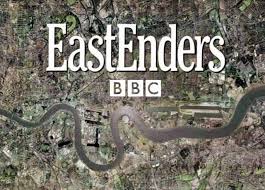
An example of a dual narrative is 8 Mile, as it simply follows the events and challenges that Eminem's character faces as he attempts to make a life for himself using rap.
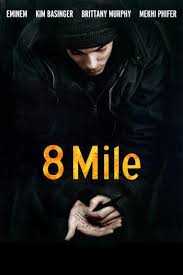
An example of a film with action codes is Spiderman, as all events in the film occur as a consequence of another action. For example:
- A radioactive spider bites Peter Parker
- Peter gains super powers and practices them
- Peter uses these powers against crime
- A burglar murders Peter's uncle
- Peter seeks revenge
- etc.
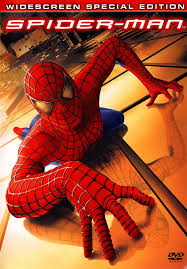
An example of a film with enigma codes is The Ring, as the main character spends the duration of the film unraveling the mystery of why her niece's death was caused by watching a video tape. The audience also participates in this journey with her as they find out elements of the past along with the heroine.
%2BThe%2BRing%2BOpt%2B2.jpg)
Tuesday 22 October 2013
Monday 30 September 2013
Research Textual Analysis: Double Idemnity by Billie Wilder
- 1944 American Film Noir
- About a provocative housewife who wishes her husband were dead
- The term 'double idemnity' refers to a clause in certain life insurance policies that doubles the payout in cases when death is caused by certain accidental means
- Stars Fred MacMurray, Barbara Stanwyck and Edward G. Robinson
- Often cited as a paradigmatic film noir and as having set the standard for the films that followed in that genre
http://www.imdb.com/title/tt0036775/
http://en.wikipedia.org/wiki/Double_Indemnity_(film)
I learnt from this example that a film of the Film Noir genre will often follow a plot line including death, law ('insurance policies'), sex ('provocative') and possibly greed ('doubles the payout'). I also learnt that a character one would probably find is a 'femme fatale' much like the 'provocative housewife' presented in Double Idemnity.
This film is a strong example of the genre because, as said above, it is 'citied as... having set the standard for the films that followed in the genre' which means that it was a base for other films in the genre and, therefore, a reliable source.
This knowledge could influence my own work when I come to creating my opening title sequence because I could create a 'femme fatale' character and I could also use the plot ideas (such as death and greed) as a base for my own story line.
Thursday 26 September 2013
Reviewing Class Sweded Films
As a class, we watched each other's productions and shared points and advice for improvement. The main points we concluded were:
- Many of the swedes didn't have a title and credits.
- More of a variety of camera angles/movements could have been used, but this was difficult when the director was also an actor.
- It was difficult when playing more than one character, and the characters could have been distinguished more clearly via costume.
- In one case, the conventions of sweded films were challenged due to editing in transitions using iMovie. This conformed to the film style, however, and the decision was made to keep them.
- In some cases, the speech was not heard clearly because the actors spoke too quietly or the camera was too far away.
Sunday 22 September 2013
Activity 2: The Core Conventions of an Opening Sequence to a Film
- The film title
- Music/sound that conforms to the film genre
- Names (and sometimes images) of the cast and crew
- Any production companies
- An introduction to the main setting/character(s)
- A variety of camera shot types to give an insight to the film genre
- Should build tension and make the audience ask questions and want to keep watching
I found this presentation on Prezi very helpful.
Acivity 1: Presentations on Opening Sequences of Films
An Analysis Of The Opening Sequence Of Vertigo from Media Studies
These are some examples of presentations on opening sequences to films.
These are some examples of presentations on opening sequences to films.
- How successful are they at identifying conventions?
- Personally, I don't think any of these presentations are particularly good at identifying the conventions of opening title sequences. There are fairly good explanations but not all of the conventions have been mentioned. All I've really learnt from them is that the director's, actor's, producer's, distributor's and editor's names are displayed as credits. I don't feel that the presentations have provided much guidance on how to film an opening title sequence as a director.
- Who is the audience?
- The audience ranges from Media/Film students to people who want to be creative and film their first movie (or short movie) and need to learn how to do this.
- What is the purpose of the presentations?
- The purpose of the presentations is to educate others that are interested in developing their knowledge of the key conventions of opening title sequences, possibly purposely providing limited information in order to encourage others to do some independent learning to fill in the rest of the information.
- Is the format successful?
- The first two presentations are successful with their format, as they are clearly showing the information that is needed. However, if I'm honest, I didn't even bother to read the third one, as I much prefer having the conventions stated clearly rather than having to sift through information trying to find the right points.
- Did they identify ALL of the conventions accurately?
- The first two presentations present different conventions, which means that they don't identify all of the conventions of opening title sequences. Also, while the first presentation identifies more conventions, the second identifies less but provides much more detailed explanation and analysis.
Saturday 14 September 2013
My Sweded Movie- Twilight

Create a Copy

Create a Copy
Above is a storyboard I made of my sweded film using a site that I found called StoryboardThat.com which I found quite fun to use. Although I'm not a paying member, so my storyboards are restricted and that's why I had to make mine in two. I decided to use the same people to distinguish my actors rather than using people that related more to the film. The girl in bunches who played the deer, Charlie and Edward represents my friend, Ailbhe. The long-haired girl represents myself playing Bella. The red-haired boy who plays Jacob represents my friend, Connor. And, lastly, the brown-haired boy represents my friend, James, who plays the teacher, the rapist and James.
At first, I chose to swede the film Air Bud which I thought was a popular film because it was one of my favourites during childhood. (As the starring dog was able to score a basket in basketball, I would throw a balloon to my dog for her to knock into the air with her nose, then I would throw a ball the same colour into the basket from a different angle.) However, I asked around and the film apparently wasn't as popular as I thought because nobody I talked to had even heard of it before. I also had limitations to the camera I was using for this first film in that I was unable to edit due to the camera being tape and this meant that I had to keep rewinding the tape to an exact point if I made any mistakes, which I grew very tired of.
I thought again about which movie to swede and decided on Twilight because it is an extremely popular film and I had thought of some ideas to add to the comedy, for example making Ailbhe dress up to look more like Dracula than the character Edward Cullen. I was also given a much better camera to borrow, of which I could edit from on my own laptop once I had found an editing software available to download for a free 30 day trial called Cyberlink Powerdirector. This saved a lot of time. I had so much fun making this, and would love to do something like this again.
Click here to watch the BLOOPERS which I also edited for my own personal entertainment.
Tuesday 27 August 2013
An Example of Sweding
Although this is a sweded trailer rather than a film, this is one that I really enjoyed.
What is a Sweded Film?
A definition I found on Urban Dictionary is 'The summarized recreation of popular pop-culture films using limited budgets and a camcorder' and another from Know Your Meme is 'Sweded Films are amateur recreations of famous films using limited resources and technology inspired by the 2008 comedy film Be Kind Rewind. The films are typically much shorter in length than their originals and use shoe-string budget props to mimic the source material.'
The blog Sweded Cinema displays these requirements for sweded films:
The blog Sweded Cinema displays these requirements for sweded films:
- Must be based on an already produced film
- Range 2-8 minutes in length
- Must not contain computer generated graphics
- Based on films less than 35 years old
- Special effects must be limited to camera tricks
and arts 'n crafts - Sound effects created by human means
- Hilarious.
Subscribe to:
Posts (Atom)




















